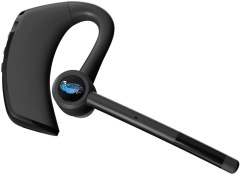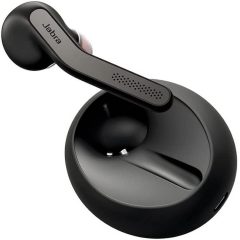BestReviews is reader-supported and may earn an affiliate commission. Details

A stereo headset that prioritizes comfort and audio quality for office or personal communications.
UC-certified for Unified Communications platforms. Boasts 37 hours of battery life on full charge or up to 9 hours on a fast charge. Excellent sound quality in both speakers and mic. Memory foam cushions for comfort.
Mic can’t be worn on right side.

Designed for truckers and people who need to make and receive calls with excellent clarity.
Three-mic digital signal processing for mic clarity. Up to 14 hours talk time. Uses Bluetooth 5.1 protocols. Rated IP54 for dust and water resistance. Customizable multifunction button. Includes ear inserts for good fit. Offers smart app.
Reports of update issues and freezes.

An earpiece headset for people who need to stay connected at work or on the move.
Noise-canceling allows you to hear calls in loud environments. Offers three-mic DSP to optimize talk clarity. Bluetooth 4.1 built-in, no dongle required. Smart app can be used to locate the headset.
Only 7 hours of talk time.

High-end audio and professional compatibility are this unit’s top selling points.
UC-certified for Unified Communications platforms. Can connect to more than one Bluetooth source at a time. Offers hearing protection against loud audio bursts. Innovative on/off control.
Expensive. 10 hours talk time.

This tiny earpiece headset charges via a separate cradle and can pair with an NFC tap.
Discreet size for staying connected while interacting with others. Noise cancelling mics for clarity. Offers tap-to-pair NFC technology. Summons digital assistants with simple tap gestures.
10 hours talk time. Charges only on cradle.

We recommend these products based on an intensive research process that's designed to cut through the noise and find the top products in this space. Guided by experts, we spend hours looking into the factors that matter, to bring you these selections.

Are you in the market for a Bluetooth headset? This technology is great if you want to:
The Bluetooth device market is saturated with hundreds of makes and models, ranging from high-grade products to flimsy wears. Without testing them first, it’s difficult to know whether any given product is worth the cash.
That’s where we come in. At BestReviews, our goal is to provide consumers with honest, unbiased reviews of the best products available. For this reason, we never accept “free” manufacturer samples. We buy products off of store shelves just as you do, and we scrutinize them for quality.

Each Bluetooth device offers features that make whatever you’re doing easier. The best device for you is one that best meets your needs.
So why do you want a Bluetooth headset? How will you use it?
The “average” consumer uses Bluetooth headphones for:
In these scenarios, the headset rarely leaves the owner’s home, office, or pocket. It sits on its charger much of the time and isn’t subjected to extraordinary wear and tear.

Do you spend lots of time commuting in a car, subway, or plane? If so, you need a device that can pretty much go anywhere and be ready to take a call at a moment’s notice. Motorola and JETech offer some terrific options for people who travel frequently, like battery life of up to 12 hours and a noise-canceling microphone to suit those who may find themselves working on a crowded train or in a noisy airport.
Do you use your device when you’re working out at the gym? While you’re biking or jogging? People who exercise while wearing their Bluetooth device need something that can withstand extensive movement and sweat. The LG brand offers some of the best headsets in terms of comfort, durability, and sustainability for extended periods of time.
No two Bluetooth models are exactly alike. Each manufacturer has its own spin on what’s considered a “Bluetooth necessity.” Consider the following features when deciding what you value the most:

The greatest concern for anyone buying a headset is the type of audio quality they’re going to get. We could pontificate on signal strength and the integrity of the audio you load/stream onto your device. But ultimately, just being able to hear it properly is probably the top concern for people purchasing a Bluetooth device.
The two most popular systems for smartphones are iOS and Android. Each contains its own voice prompt system with the built-in Siri and the downloadable Cortana, respectively.
However, the fact that you have a system doesn’t mean your Bluetooth will respond to it. That may sound odd, but keep this in mind: few cellphone designers create their own wireless headphone system. With the exception of the iPhone 7, most everything still operates with a headphone jack.
Because of this, most headphones that contain a microphone and button system are compatible with voice prompts. But not every Bluetooth device follows suit. The JETech, for example, doesn’t respond to voice prompts and contains no software to correct the issue — it’s simply for listening.
Whatever device you use, you can adjust its volume with built-in audio controls. For example, most cell phones sport a volume control button on the side.
Many Bluetooth devices include their own built-in volume controls as well. Interestingly, when you connect two devices with two different sets of volume controls, you may experience your own set of problems. For example, one of the two devices might be turned low or muted, causing you to think it’s broken. Or worse, both devices might be turned up at the same time, causing you to accidentally blast your eardrums.
One of the biggest issues you’ll face as a Bluetooth headset owner is battery life. Regardless of which brand you purchase, your Bluetooth will likely take a few hours to charge.
The Motorola, at full charge, offers a 12-hour battery life. The rest of the leading competitors last anywhere from four to ten hours. But regardless of which you choose, we recommend charging your device at least once a day so you get the most out of the set.
Human ears simply weren’t designed to hold up large pieces of plastic for long periods of time. Comfort can be an issue when it comes to Bluetooth headsets. The designs by LG, Motorola, and Jabra on our shortlist score highest when it comes to overall comfort.
Most devices are going to pick up some background noise. There’s just no avoiding it, especially if you’re outside or in a place where there’s a lot going on.
The model that comes the closest to relieving the background noise problem is the JETech, which has noise-canceling properties. Even with the JETech, however, you’ll likely encounter a tiny bit of background noise if you’re in a place with lots of commotion.
As mentioned above, signal quality can be a hassle. The signal between your device and the Bluetooth device can also be a challenge. Fortunately, many manufacturers have corrected this problem over the past several years. But some brands still suffer from an occasional loss of connectivity.
Many cell phone carriers already have delayed responses in phone conversations. When it comes to Bluetooth, these delays can increase further.
When you talk into a phone, you’re basically sending your signal to a tower, then to space, then back to another tower, and finally to the other person. A Bluetooth device, no matter how good it is, adds yet another layer of delay on top of that, resulting in a lag of up to three seconds. It’s an annoyance that may cause problems down the road.

Most modern Bluetooth devices aren’t, shall we say, discrete. When it comes to style, a lot of Bluetooth devices still look a bit clunky.
If you’re concerned about how you look while wearing your headset, we recommend you take a look at the Jabra and JETech models. The sleekest of our top-pick models, they use the least amount of materials and fit comfortably around your earlobe so you can hide most of the plastic. And there are no bulky pieces or massive logos that make you look like Uhura from Star Trek.
Prices range from under $10 to around $100 for a Bluetooth headset. Each product has its own great features and potential problems.
Purchasing Tips
We advise potential buyers to select a device with specs that accommodate their needs. That said, these tips should help anyone find a better Bluetooth headset.

Q. How do I pair my headset with my device?
A. Every setup is different, but it typically works like this: you turn your device on and hear a set of tones. (The tones are the Bluetooth sending a signal out to whatever devices may be active nearby.) You then choose which device you want to connect to and sync them up using the instructions.
Q. Are all devices compatible?
A. The vast majority of Bluetooth devices will connect to whatever you’re using. (Devices with out-of-date software may be an exception to this rule.) Sometimes you need to browse your options menus to get the devices to connect, but everything should work in short order.
Q. How badly will a Bluetooth headset hurt my ears?
A. Theoretically, your Bluetooth headset shouldn’t hurt your ears at all. But everyone is different. Ear size varies, as does an individual’s sensitivity to sound. If you purchase a headset and experience discomfort beyond the first few uses, find a new pair. You shouldn’t need to hurt yourself to make it work right.
Q. How breakable are these? Can I repair them?
A. Bluetooth devices are a lot like earbuds. They’re small and can take some bumps, but they’re not indestructible. If you put them through a ton of use or throw them around, they will break. We don’t recommend repairing them yourself. Find whatever warranty comes with your device and sign up for it. Unless the damage is superficial or could be fixed with a cleaning, most companies with an applicable warranty will replace the product rather than trying to fix it.
Get emails you’ll love.
Learn about the products you’re wondering if you should buy and get advice on using your latest purchases.
